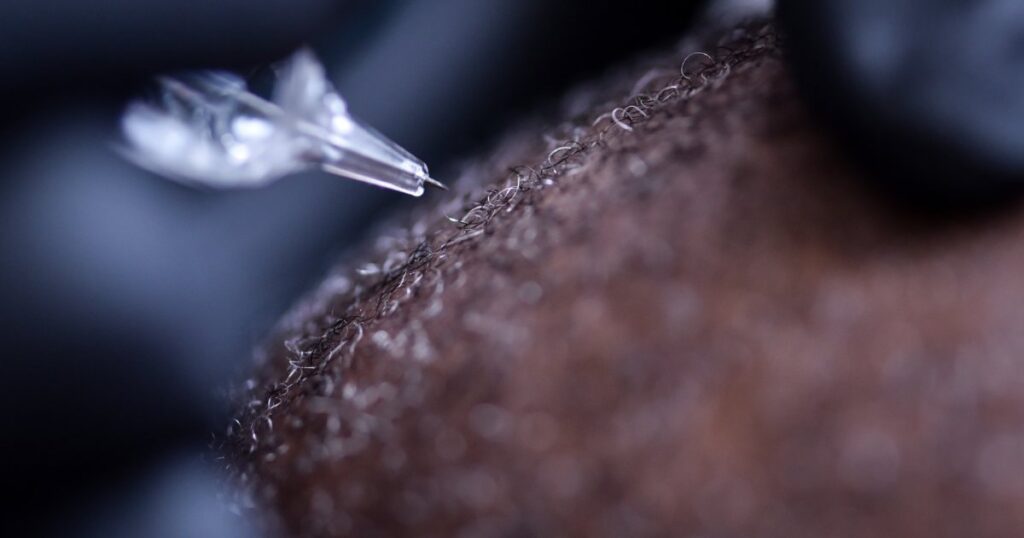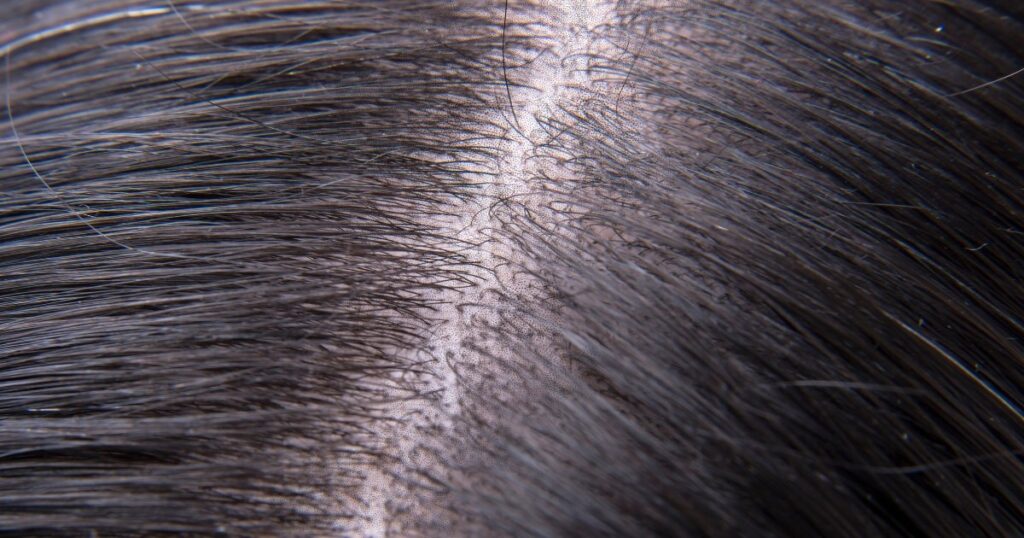
Hair loss affects millions worldwide, often impacting self-confidence and self-esteem. Female pattern hair loss is a common issue affecting over 50% of women, particularly those over 40 or going through menopause. Fortunately, advancements in cosmetic treatments provide innovative solutions. Scalp Micropigmentation (SMP) stands out as a revolutionary approach to address hair loss without invasive surgery. By simulating the look of hair follicles on the scalp skin, SMP creates the appearance of a fuller head of hair, boosting confidence and offering a low-maintenance alternative to traditional hair restoration methods. But what exactly does the SMP process entail, and is it worth it? Let’s explore everything you need to know.
What is Scalp Micropigmentation?
Scalp Micropigmentation, or SMP, is a non-surgical cosmetic treatment that involves depositing tiny dots of pigment onto the scalp. These dots are strategically placed to replicate the look of hair follicles, creating an illusion of thicker hair and a fuller hairline. SMP is often referred to as a hair tattoo; however, unlike regular tattoos, SMP uses specialized pigments and equipment to achieve subtle, natural-looking results. For individuals dealing with thin hair, receding hairlines, alopecia areata, or scalp scars from previous hair transplant procedures, SMP offers a versatile and customizable solution.
The SMP Process: Step-by-Step Breakdown
The SMP process is methodical, involving multiple stages to ensure lasting, natural results. Here’s a closer look at what to expect:
Initial Consultation
The SMP journey begins with a free consultation. This session allows the SMP practitioner to assess the client’s scalp skin, existing hair, and hair loss patterns. The practitioner will discuss aesthetic goals, examine hair color and skin tone, and review any previous hair transplants. Clients can express preferences, such as achieving a shaved head look or enhancing the density of longer hair.
Design and Pigment Selection
In the next phase, the practitioner selects scalp micropigmentation pigments that blend seamlessly with the client’s natural hair color. Unlike tattoo ink, SMP pigments are designed to retain their color and fade naturally over time, avoiding the common color-shifting issues associated with traditional permanent makeup. The practitioner will also map out the desired hairline or density pattern, considering the client’s facial structure and family history of hair loss.
Initial SMP Session
The first session marks the start of the actual SMP treatment. Using a specialized micro-needle, the practitioner deposits tiny dots of pigment into the scalp, replicating the look of hair follicles. The precision of each dot’s placement is crucial, as it determines how well the treatment will mimic natural hair growth. This session can last anywhere from 2 to 5 hours, depending on the area being treated. For those with extensive bald spots or thinning areas, this stage can take longer.
Subsequent SMP Sessions for Optimal Density
SMP typically requires 2-3 sessions to achieve the desired hair density. Each session allows the practitioner to build on previous work, adjusting pigment levels, blending patterns, and refining details. These sessions are usually scheduled 1-2 weeks apart to let the scalp heal and for the pigments to settle. The layered approach helps create depth, giving the illusion of fuller hair roots and a more realistic outcome.
Healing and Aftercare
After each session, clients receive aftercare instructions to ensure proper healing. During this period, the scalp may feel slightly tender, and clients may notice scalp visibility decrease as the pigment settles. It’s advised to avoid sun exposure, steam rooms, and intense exercise that causes heavy sweating. Keeping the scalp dry with a shower cap and avoiding hot environments is also recommended to protect the treatment area. The scalp may appear slightly red initially, but this fades within a day or two, revealing a more defined look.
Long-Term Maintenance and Occasional Touch-Ups
SMP is known for being a low maintenance solution. Results can last for several years, but the treatment may require occasional touch-ups to maintain optimal color and natural results. Factors like lifestyle, sun exposure, and individual skin type can affect the longevity of SMP. A quick touch-up every 3-5 years helps keep the pigments vibrant and consistent.
Finding an Expert SMP Provider
Finding an expert SMP provider is crucial for achieving the best results from scalp micropigmentation. Here are some tips to help you find a qualified SMP provider:
Research Online: Start by looking for SMP providers in your area. Check their websites, social media profiles, and online reviews to get a sense of their reputation and expertise.
Check Credentials: Ensure the provider is licensed and certified in micropigmentation. This guarantees they have undergone the necessary training and adhere to industry standards.
Ask for Referrals: Seek recommendations from friends, family, or your doctor. Personal referrals can provide valuable insights into the provider’s skills and professionalism.
Review Their Portfolio: Examine before and after photos of their previous work. This will help you assess their experience with cases similar to yours and ensure they can deliver the desired results.
Schedule a Consultation: Meet with the provider to discuss your needs and expectations. A consultation allows you to ask questions, understand the process, and gauge your comfort level with the practitioner.
SMP Removal: What You Need to Know
While SMP is a long-lasting solution, it’s not permanent. Over time, the pigments can fade, and some patients may prefer a touch-up session to maintain the desired appearance. Here are some things to know about SMP removal:
Fading: SMP pigments can fade over time due to factors like UV light exposure, skin aging, and individual skin characteristics. This natural fading process means that touch-ups may be needed to keep the look fresh.
Touch-Ups: Regular touch-ups can help maintain the desired appearance and prevent noticeable fading. These sessions are typically less intensive than the initial treatment and can be scheduled every few years.
Removal Methods: If you decide to remove SMP pigments, several methods are available, including laser removal and saline solution removal. Laser removal is the most common and effective method, though it may require multiple sessions.
Cost: The cost of SMP removal varies depending on the method and the number of sessions required. It’s important to discuss these details with your provider to understand the financial commitment involved.
Realistic Expectations from SMP
While SMP can achieve amazing results, it’s essential to have realistic expectations. Here are some things to keep in mind:
SMP is Not a Hair Growth Solution: SMP is a cosmetic treatment that creates the appearance of thicker hair, but it does not stimulate natural hair growth. It’s designed to mimic the look of hair follicles, providing a fuller appearance.
SMP is Not a Substitute for Hair Transplants: While SMP can complement hair transplants by adding density and covering scars, it’s not a replacement for surgical hair restoration. It’s an excellent option for those who cannot undergo hair transplants or want a non-surgical solution.
SMP Requires Maintenance: Regular touch-ups are necessary to maintain the desired appearance. The frequency of touch-ups depends on factors like skin type, lifestyle, and sun exposure.
SMP is Not Suitable for Everyone: Individuals with certain skin conditions, such as psoriasis or eczema, may not be ideal candidates for SMP. It’s important to consult with a qualified provider to determine if SMP is right for you.
Why Choose Scalp Micropigmentation Over Hair Transplants?
Many clients wonder how SMP compares to traditional hair transplantation methods. While hair transplants focus on moving existing hair follicles from one area to another, SMP provides an alternative by simulating the look of hair. Here are some key reasons why SMP may be the preferred choice for many:
Immediate Results: Unlike hair transplants that take months for hair growth to become visible, SMP provides an instant transformation.
Non-Surgical: SMP requires no incisions, meaning there’s minimal risk of infection or allergic reaction.
Low Maintenance: Once healed, SMP requires little to no daily upkeep.
Affordability: Compared to hair transplants, SMP is often more affordable while delivering lasting results.
Scar Camouflage: SMP can effectively cover scalp scars from prior hair transplant procedures or injuries, blending them into a natural-looking hair density.
To be very clear we recommend restoring your natural hair to its fullest ability. However, there are situations where you might not be able to regrow your hair, because of a few different issues that have led to excessive hair loss.
In some cases where people have had gone through multiple failed hair transplants to the point where there is not a “safe” amount of hair grafts to extract to keep the scalp looking full and natural all over. There are also some cases when patients have gone through radiation and chemo therapy treatment for cancer.
Unfortunately there are cases where after recovery the tissue in the scalp and/or the hair follicles are so damaged do to the treatments that they can no longer support new hair growth in specific regions of the scalp.
Is Scalp Micropigmentation Worth It?
When considering whether scalp micropigmentation is worth it, the answer is a resounding yes for many. Here’s why SMP is valued as a top hair loss solution:
Realistic Results: SMP creates a natural-looking illusion of hair follicles, making it ideal for those who prefer a subtle enhancement and gives some the extra coverage where they need it.
Confidence Boost: Many clients report a significant improvement in self-esteem after undergoing SMP, as it addresses the emotional impact of hair loss.
Customizable for All Styles: Whether clients desire a buzz cut, shaved head look, or added density for thinning hair, SMP is versatile and adaptable.
Long-Lasting Solution: Unlike other hair loss solutions, SMP offers a lasting result that can go for years with only minimal touch-ups.
When Should You Consider Scalp Micropigmentation?
Determining the right time to undergo SMP depends on individual hair loss progression and personal goals. Here are some ideal scenarios where SMP might be the best choice:
Early Stages of Hair Thinning or Receding Hairline
If you’re noticing thinning hair or a receding hairline, SMP can fill in these areas, giving the illusion of thicker hair. The treatment works well even in early stages, providing a preventative approach to hair loss without committing to invasive surgery.
Post-Hair Transplant Enhancements
Some clients seek SMP after a hair transplant to boost hair density in areas where hair growth may still appear sparse. SMP blends seamlessly with existing hair and camouflages any hair transplant scars, adding depth and fullness. Additionally, hair transplant scars smp is an effective method for concealing scars from follicular unit excision (FUE) or traditional surgical techniques, although it poses challenges due to the unpredictable nature of pigment placement in scar tissue.
Alopecia and Other Hair Loss Conditions
For individuals with alopecia areata or pattern hair loss, SMP can offer a non-surgical solution that covers bald spotsand minimizes scalp visibility. It provides a consistent appearance, even for those experiencing fluctuating hair loss.
Clients Seeking a Low-Maintenance Hair Solution
For those who want a stylish yet hassle-free look, SMP is perfect. It’s an easy alternative to styling products, allowing clients to enjoy a shaved head or natural-looking hairline without daily styling.
Frequently Asked Questions About SMP

Does SMP Hurt?
Clients often describe the SMP sensation as similar to a light scratching or tingling. An experienced SMP artist can apply numbing cream to minimize discomfort, though most find the procedure tolerable.
How Long Do SMP Sessions Take?
An SMP session can last anywhere from 2 to 5 hours, depending on the treatment area’s size. Multiple sessions ensure the best results and lasting density.
What Happens If I Change My Mind?
SMP is semi-permanent, meaning pigments naturally fade over several years. However, if desired, laser removal is available, though this is rare due to SMP’s high satisfaction rates.
How Does SMP Differ from a Regular Tattoo?
SMP uses unique pigments designed specifically for the scalp, ensuring they do not turn unnatural colors over time. The technique also involves tiny dots rather than shading or lines, allowing for a realistic hair follicle effect.
What Should I Avoid After Treatment?
After each session, clients should keep the scalp dry, avoid sun exposure, and refrain from activities like swimming or using steam rooms for the first few days.
How Many Treatments Are Needed for SMP?
Most clients require 2-3 treatments to achieve optimal results. Each session builds on the last, adding depth and density to the scalp micropigmentation effect.
The Benefits of Scalp Micropigmentation for Different Hair Types
SMP is suitable for various hair types and styles, making it an inclusive option for clients of all backgrounds:
Long Hair: SMP can add density to thinning areas without altering the length or natural look of longer hair.
Short Hairstyles: For those with shaved hair or buzz cuts, SMP creates a consistent, full look that enhances facial features.
Curly and Coily Hair: SMP practitioners can customize dot placement for natural results that blend well with all hair textures.
Cost of SMP

The cost of SMP varies depending on the provider, location, and the number of sessions required. Here are some things to consider:
Cost per Session: The cost per session can range from $500 to $5,000, depending on the provider and the size of the area being treated. It’s important to get a detailed quote during your consultation.
Package Deals: Some providers offer package deals that include multiple sessions at a discounted rate. This can be a cost-effective option if you require several sessions to achieve the desired results.
Financing Options: To make SMP more affordable, some providers offer financing options, such as payment plans or credit cards. Be sure to inquire about these options during your consultation.
Insurance Coverage: SMP is typically considered a cosmetic treatment and is not covered by insurance. However, it’s always a good idea to check with your insurance provider to confirm.
By understanding the costs and available payment options, you can make an informed decision about investing in SMP as a hair restoration solution.
Why SMP is a Smart Investment in Hair Restoration
For those dealing with hair loss, SMP represents an investment in both appearance and confidence. Here’s a summary of SMP’s most compelling benefits:
Affordability: SMP costs significantly less than it has been made out to be.
Long-Lasting Results: Some SMP results can last years with minimal need for touch-ups, offering excellent value.
Natural Look: By replicating hair follicles through tiny dots that blend with existing hair, SMP provides an unmatched level of realism.
